by Margaret Linford | Dec 20, 2017 | 01 What's New, Cemeteries |
Cemetery research is a crucial family history skill. Tombstones are monuments to our ancestors lives and may have key genealogical clues engraved in the stone. Follow these four steps to finding your ancestors’ burial places and the records that complement them.
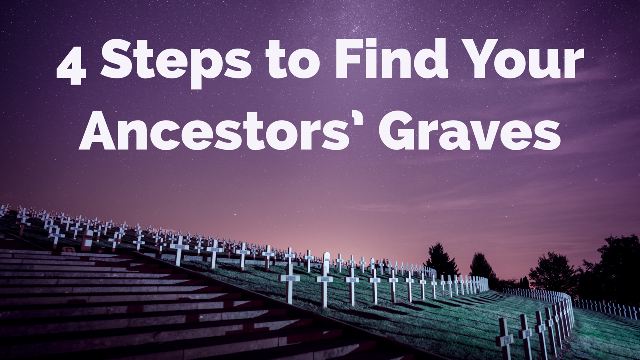
Many of my ancestors are buried just two miles from my house in Round Hill Cemetery in Marion, Virginia. I drive by the cemetery each day, as I take my daughters to school. I never pass by without glancing up at the hallowed ground which holds the remains of those who came before me. The sun perfectly illuminates their resting place each morning and a majestic tree stands at the very top of the hill–a living monument to the lives they led in the town where I now raise my own family.
It is an emotional experience to stand in the place where an ancestor’s remains have been laid to rest.
Each time I visit the grave of my grandma, I have a vision of a family standing around a casket on a bitter cold day in March. It was a just few days before the official start of spring, but it was the dead of winter to me. That ground is sacred to me, now.
Each time I visit, I am transported back in time to that day. A wound is re-opened for a moment, but the moment is fleeting because I quickly remember her life, not her death.
I remember the stories she told, the service her hands rendered to her family and, most importantly, the love that transcends time and even the icy grip of death. Death truly loses its “sting” as we stand before a monument of stone and see beyond to the life it represents. Scenes like this one have played out at each grave.
I am reminded of this quote from Fear Nothing, a Dean Koontz book, whenever I visit the cemetery:
“The trunks of six giant oaks rise like columns supporting a ceiling formed by their interlocking crowns. In the quiet space below, is laid out an aisle similar to those in any library. The gravestones are like rows of books bearing the names of those whose names have been blotted from the pages of life; who have been forgotten elsewhere but are remembered here.”
I have often gone to my ancestors’ resting places to take pictures of headstones and search for relatives I may have missed in the past. It seems like each time I visit, I notice something new.
This library of marble holds many clues that have helped me break down brick walls in my family history research. These clues have been there, etched in stone, for decades. It wasn’t until I recognized how to read the clues that I began to understand the importance of cemeteries in family history research.
These resting places have become much more to me than merely a place to go and offer a bouquet of flowers. There are answers waiting to be discovered. The key to getting the answers is knowing which questions to ask.
In my experience, the best genealogists are not the ones with the best cameras, the best software, or the best gadgets–they are the ones with the best questions.
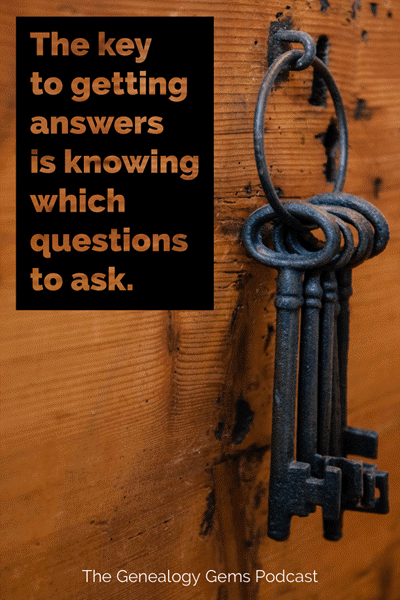
Curiosity is the most important tool to the successful genealogist. The next time you find yourself in a library of marble, take a few moments to let your curiosity run wild. Ask yourself:
- “Who are the people surrounding my family members?
- What are their stories?
- What do the etchings on their headstones mean?”
That curiosity will lead to the most remarkable discoveries and you will see for yourself how a piece of marble truly can break down a brick wall.
Below I’ve outlined the steps for finding family cemeteries and which questions you should be asking when you get there. Get inspired by my own examples of breaking down brick walls, and implement these methods I used for your own success!
Cemetery research step #1: Identify the cemetery
The first step in cemetery research is to identify the name of the cemetery where an ancestor was buried.
The best places to start looking are death certificates, funeral home records and obituaries. Each one of these records should contain the name of the cemetery where a family member was buried.
We sometimes fail to look beyond the names and dates on death certificates. If we get in the habit of taking the time to absorb all of the information on these important documents, we will find genealogical treasure.
Sometimes, the death certificate will not give us the name of the cemetery.
This was the case with my great-grandmother, Mollie Weimer Overbay. I was frustrated to see that the death certificate only indicated that she was buried, as opposed to cremated or removed to another location. While the certificate did not provide me with the name of a cemetery, it did offer the name of the funeral director: W.B. Seaver.
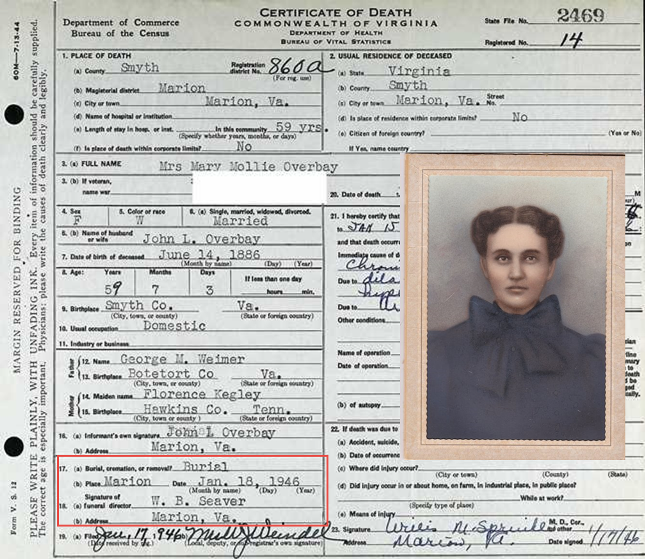
Luckily, I was able to follow this lead to the local funeral home. Within their records, I discovered that she was buried in Round Hill Cemetery, along with many of my other ancestors.
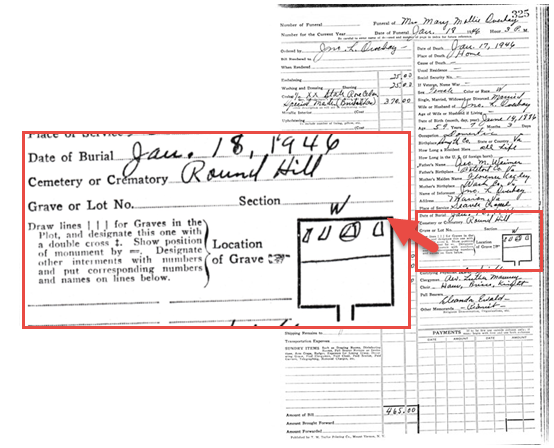
Cemetery research step #2: Locate the cemetery
Once you have located the name of the cemetery, several resources can guide you to its location.
Three helpful websites are listed below. Which you choose may depend on personal preference or familiarity but also on which site seems to have more records for the locales of most interest to you.
1. One of my favorite online resources is Find A Grave.
This website allows you to search for cemeteries all over the world.
At the home page, click on the Cemeteries tab (#1, below).
Then enter the name or location of the cemetery (#2). In the screenshot below, you can see part of the Google Maps interface that shows you the exact location of the cemetery, should you want to visit in person:
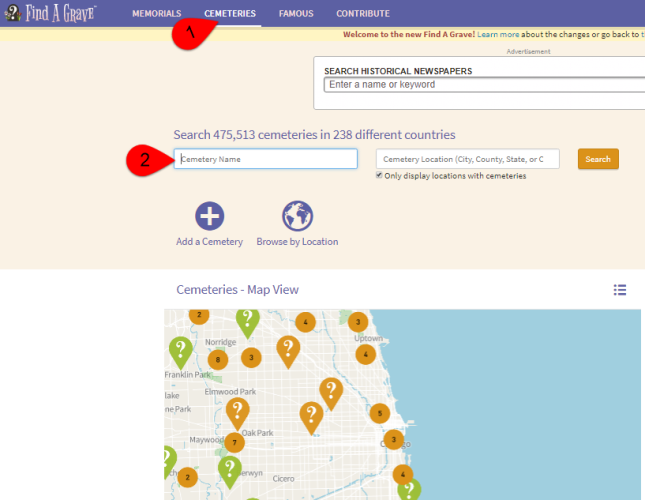
Find A Grave also has pictures of many of the headstones located within cemeteries.
2. 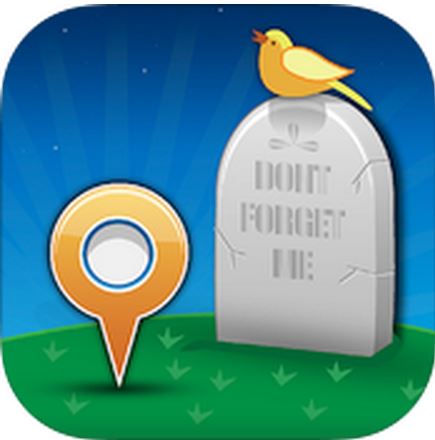 Billion Graves allows users to collect photos of headstones by using an iPhone/Android camera app.
Billion Graves allows users to collect photos of headstones by using an iPhone/Android camera app.
The app, available on Google Play and the App Store (for iPhone and iPad), tags the photos with the GPS location and, essentially, maps the cemetery as headstones are added.
Search for cemetery locations using the Billion Graves app or on the website by selecting the “Cemetery Search” option and then entering the name of the cemetery or a known address (to see it on Google Maps):
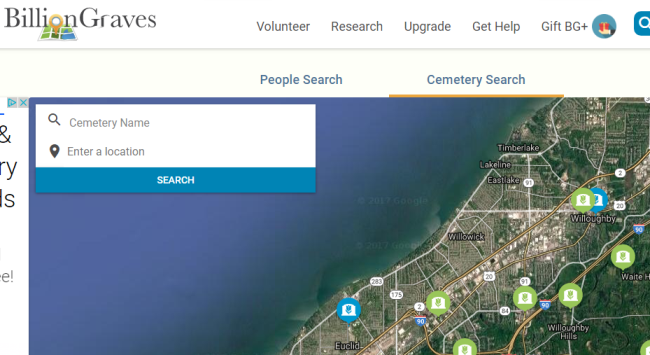
3. Interment.net can also be helpful.
From the home page, scroll down just a little until you see “Browse Cemetery Records by Region.” This can be especially helpful if you’re looking for all records within a specific county or other region. However, it’s not quite as useful if you’re trying to locate all cemeteries within a certain radius of a location, regardless of local boundaries.
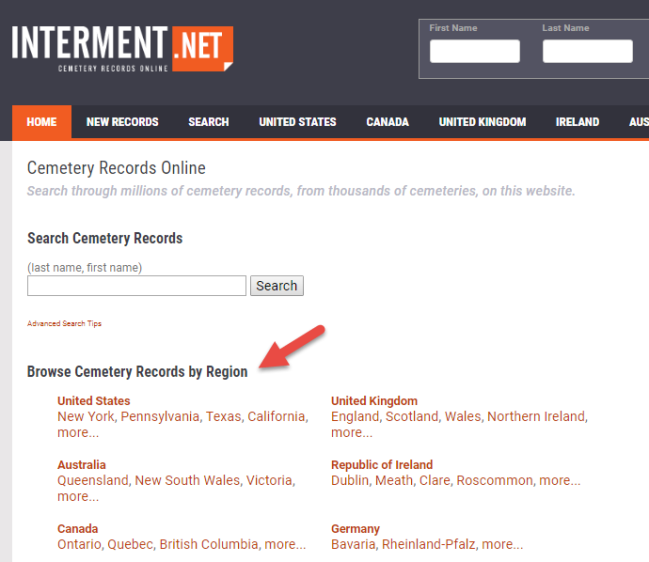
In addition to these resources, it is essential to contact the local library, genealogical society, and/or historical society where your ancestors are buried. These organizations are well-known for maintaining detailed listings of local cemeteries within their collections.
For instance, within Smyth County (where I live) there is a four-volume set of books that contains the work of two local historians, Mack and Kenny Sturgill. They spent several years mapping local cemeteries and collecting the names on all of the headstones.
Although these books were completed in the 1990s, the information is still valuable to genealogists. Detailed driving directions were given to help future researchers locate cemeteries that would otherwise be difficult to locate. Many of them are on private property and even in the middle of cow pastures or wooded areas.
Furthermore, some of the headstones that were legible in the 1990s have now become difficult to decipher due to weathering or have altogether disappeared. It is likely that the counties in which you are conducting cemetery research offer similar resources.
Cemetery research step #3: Prepare for a visit
Once you have found the cemetery you want to visit, you will want to take the following items along with you to make the most of your visit:
- a camera
- pair of gloves
- grass clippers
- notebook and pen
- long pants
- sturdy shoes
You may also want to use a damp cloth to bring out the carvings on headstones. A side note: if you are like me and have an aversion to snakes, you will either choose to go on cemetery expeditions during the winter, or you will invest in a pair of snake chaps.

Get more help! The Family Tree Cemetery Field Guide (above) contains detailed step-by-steps for using FindAGrave and BillionsGraves, plus guides for understanding tombstone epitaphs and symbol meanings.
Disclosure: Genealogy Gems is a participant in the Amazon Services LLC Associates Program, an affiliate advertising program designed to provide a means for sites to earn advertising fees by advertising and linking to Amazon.com. Thank you for supporting our free podcast by using our link.
Cemetery research step #4: Visit and search for clues

This headstone shows something unusual: the couple’s ham radio call signs (the codes engraved just below their names).
The headstones found in cemeteries can reveal much about your family. You will find more than birth and death dates. If you look closely, you will discover symbols related to military service and religious beliefs, maiden names of the women in your family, and you may even find family members that you never knew about. Many times, you will find children buried in the family plot. Look around to see who is buried near your ancestors. It is likely that you will find connections to other family members when you are visiting the cemetery. These connections may lead you to break down long-standing brick walls within your family history.
In my own experience, there have been several instances in which cemetery research has helped shed light on a family mystery. I had grown up hearing that there were members of our family who had fought in the Civil War. Who were these men? What experiences did they have during the war? Where had they fought?
The answers to these questions came as the result of a visit to the cemetery. I had gone to Round Hill Cemetery to photograph the headstones of my Weimer ancestors. As I worked my way down the row, I encountered an unfamiliar name—William Henry Wymer. At the top of his headstone, there was a Southern Cross of Honor—a symbol used to denote a soldier who fought during the Civil War. Below his name was the following inscription: “Co. A, 6 VA RES, C.S.A:”
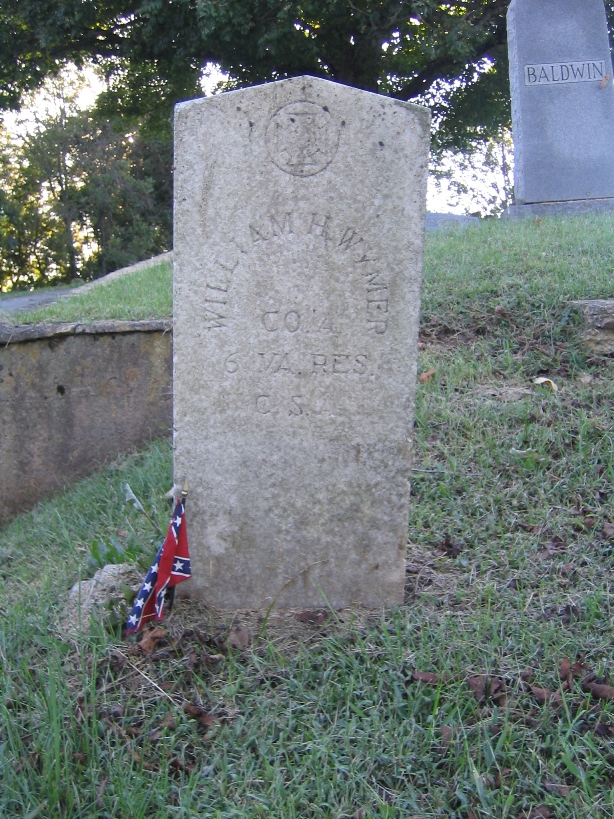
When I went home that afternoon, I began to search for more details. With some census research, I learned that he was the uncle of my great-grandmother, Mollie Weimer Overbay. Upon confirming his relationship to our family, I began searching for a pension application for his wife, Rhoda:
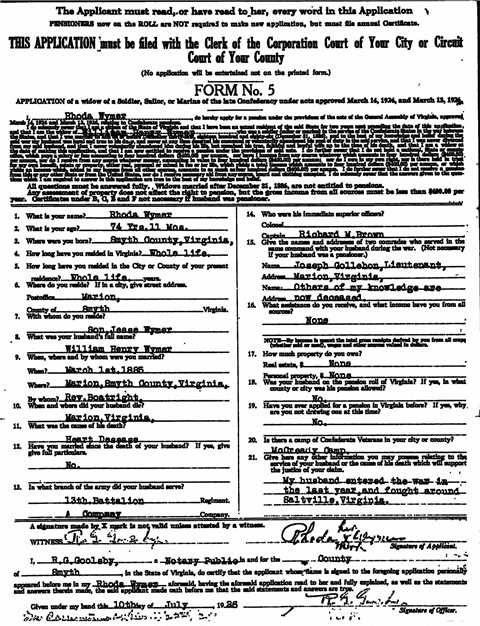
The application had been submitted in 1926 and told the story of William’s life. Among other things, I learned the answers to my questions about his service during the Civil War. His wife indicated that he enlisted during the last year of the war and was present during a well-known battle in our county—the Battle of Saltville. I am sure that my great-grandmother had grown up listening to tales of this battle and William’s experience during the war. The details of the story had been lost but were now re-discovered thanks to a trip to the cemetery.
Subtle clues like this one await you as you search out your own ancestors. The next time you make a trip to one of these libraries of marble, take a few moments to look closely at the clues that surround you. They may not be obvious, but they are there, waiting for your curiosity to uncover them. So, bring your cameras, your gloves, and your grass clippers to the cemetery on your next visit—but don’t forget to bring your questions and your ability to perceive the minute details, as you stand beneath the towering trees, among the rows of marble, waiting to offer up their long-held secrets.
More cemetery research tips
Disclosure: This article contains affiliate links and Genealogy Gems will be compensated if you make a purchase after clicking on these links (at no additional cost to you). Thank you for supporting Genealogy Gems.
by Lisa Cooke | Jul 22, 2017 | 01 What's New, Legacy Tree Genealogists, Swedish |
Beginning Swedish genealogy can be daunting. But don’t let language barriers or unfamiliar naming traditions deter you! Check out these getting-started tips from an expert at Legacy Tree Genealogists.
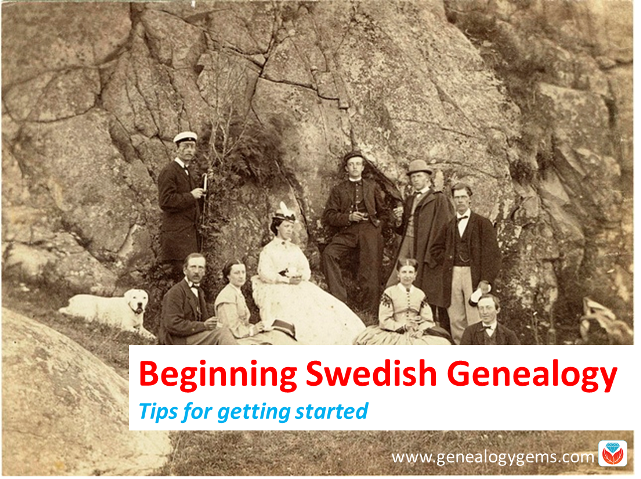
 This guest post comes from Paul Woodbury, a Senior Genealogist with Legacy Tree Genealogists. He’s an internationally recognized genetic genealogy expert and his varied geographical interests include Scandinavia. Thanks, Paul!
This guest post comes from Paul Woodbury, a Senior Genealogist with Legacy Tree Genealogists. He’s an internationally recognized genetic genealogy expert and his varied geographical interests include Scandinavia. Thanks, Paul!
Many people avoid Swedish research because they don’t speak the language and because the names change every generation–like from Ole Olsson to Ole Nilsson to Nils Pehrrson. Despite these barriers, Swedish research can be relatively simple, fun, and successful for several reasons.
1. You can “read” many records without reading Swedish.
Particularly in late 18th and 19th century records, you don’t need in-depth Swedish language skills to make exciting discoveries. Swedish church records of the time were kept in tables and were largely composed of names, dates, and residences. Records include those of:
- Birth and christening (födelse och döpte)
- Marriage and engagement (lysning och vigsel)
- Death and burial (död och begravning)
- Moving-in lists (inflyttade) and moving-out lists (utflyttade)
- Clerical examination (“husförhörslängd”)–more on these below.
Dates were frequently recorded in number formats according to the European system (dd-mm-yyyy). As a result, researchers can learn a great deal from Swedish documents with little knowledge of the Swedish language. For the few additional words you may need to learn, consider reviewing this list of words commonly found in Swedish documents available through FamilySearch.org.
2. Family events are summarized in Swedish clerical examinations.
The clerical examination or “husförhörslängd” can act as an index to important family events. Beginning in 1686, each parish was required to keep a household examination for each household. Many early records don’t survive, but copies of these records exist for many parishes in Sweden after about 1780. As part of the household examination, parish priests of the Swedish Lutheran church were required to visit with the members of their parish at least once yearly and test them on their knowledge of the catechism.
Typically, these registers document a family over the course of 5-10 years. They not only include information about the family’s religious duties, but additional information regarding migration, family structure, residence and important family events. If a child was born, he or she was added to the clerical examination, and the birth date and christening date were noted. If an individual or a family moved within the parish, a note was made in the clerical examination with a reference to the page number of the family’s new residence. If they moved out of the parish, the date they left was often recorded along with the number of their entry in the moving-out books. The dates of deaths, confirmations, marriages, vaccinations and communions were also recorded. If you are lucky, additional notes might comment on crimes, physical characteristics, occupations, punishments, social standing, economic status, or other life events with references to pertinent records.

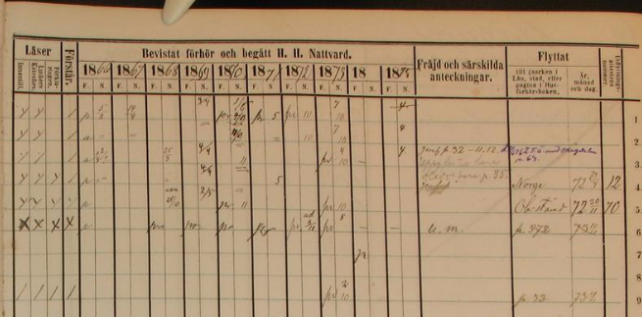
ArkivDigital, Dals-Ed (P) AI:15 (1866-1875), clerical examination, household of Per Johansson, Image 74 / page 64, https://app.arkivdigital.se, subscription database, accessed July 2017.
The above Household Clerical Examination in Dals-Ed Parish in Älvsborg covers 1866-1875 and shows the household of Per Johansson on the farm of Lilla Wahlberg in Bälnäs. The document provides birth dates and places for each household member. It shows that Per’s son, Andreas, moved to Norway in 1872. Another son, Emanuel, moved within the parish but returned after just a month. Among other notes on the document, we learn that Emanuel only had one eye and that he was a dwarf.
3. Many Swedish records cross-reference each other.
Clerical examinations reference other church records, such as those of a child’s birth or a couple’s marriage. But the reverse is also true: birth, marriage, death and migration records frequently reference household examinations. Birth records might list the page number of the child’s family in the household examination. Marriage records indicate the corresponding pages of the residences of the bride and the groom. Death records identify the residence of the deceased. Moving-in and moving-out records frequently report the corresponding page numbers of the farm where a migrant eventually settled or the parish from whence he came.
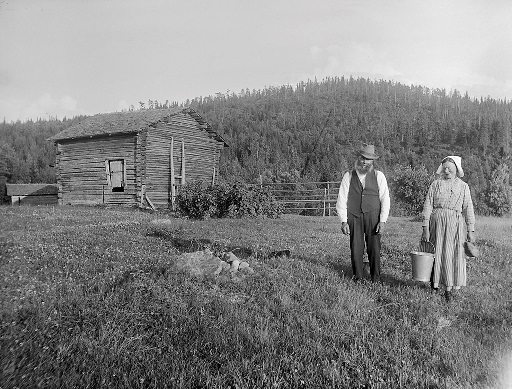
The yeoman farmer Ollas Per Persson and his wife Greta at a hut in Dalecarlia. Photograph by: Einar Erici, c1930. Wikimedia Commons image, Permission granted Swedish National Heritage Board @ Flickr Commons.
Most clerical examination buy medication for anxiety volumes include an index of farms and residences within the parish. In the case of some larger parishes and cities, local genealogical societies have sometimes indexed all individuals in the volume by name. When researching in multiple volumes, note the farm or residence of your ancestor in the previous record and then search the index of residences near the front or end of the next clerical examination volume. Usually, this will narrow your search to just a few pages out of the book rather than the entire volume.
4. You can trouble-shoot record gaps.
Even when an ancestor’s record trail turns cold, recent publications and indexes created by active Swedish genealogical societies make it possible to pick up the trails of elusive ancestors in earlier and later records. Even if these records do not list the specific pages of interest, they may still provide the reported residences, which can then be located in the clerical examination records.
Occasionally, an ancestor might have moved in a year for which migration records are not currently available, or they might have moved to a larger city with many parishes. Other times, their migration may not have been noted, or jurisdiction lines may have been redrawn resulting in the formation of a new farm and residence. In these cases it may be difficult to continue tracing an ancestor’s record trail. One strategy to overcome these situations is to search the clerical examinations by reported birth date. The birth dates or ages of Swedish ancestors are recorded in many of their records. If you are browsing through large collections, consider searching by birth date rather than by name. Since birth dates were often recorded in their own unique column and are more immediately recognizable than names, this may expedite your search. Even if these strategies still yield no results, searches in indexes may help to uncover an elusive ancestor’s record trail.
5. There are some excellent Swedish indexes and databases online.
In recent years, online indexes and databases have made Swedish genealogical research simpler than ever:
- FamilySearch.org, MyHeritage.com and Ancestry.com all have large collections of indexed birth, marriage and death records from Sweden.
- Sveriges Släktforskarföbund has compiled an index of Swedish death records from 1900 to 2013. It includes the birth dates, birth places, names, maiden names, death dates, residences at time of death, age at time of death, and if the individual was married or widowed, the index will also include the date of marriage or the date of death of their spouse. If they were not married, it will indicate their civil status. Click here to purchase the database (the price is in Swedish krona; do a Google search such as currency converter sek to usd to see the price in your country’s currency). (A related Ancestry.com database is entitled “Births from the Swedish Death Index” and only includes names, maiden name, birth dates and birth places of the individuals in the index.)
- MyHeritage has partnered with ArkivDigital to provide an index to Swedish clerical examinations between 1880 and 1920. (Indexing is underway for household examinations from 1850 to 1880.)
- Other indexed collections at ArkivDigital include the 1950 and 1960 Swedish censuses.
- Ancestry.com has indexes of Gotenburg passenger lists, which can help identify relatives who migrated from Sweden to others parts of the world.
As you can see, Swedish genealogical records from the late 1700s and 1800s can be fairly easy to read, detailed and full of cross-references. It’s often possible to trace a Swedish ancestor in every year of their life from birth to death! So don’t let language or patronymics (naming traditions) frighten you away from exploring your Swedish family tree.
Help is available when you need it
Have you hit a brick wall that could use professional help? Or maybe you simply don’t have the time for research right now? Our friends at Legacy Tree Genealogists provide full-service professional research customized to your family history, and deliver comprehensive results that will preserve your family’s legacy.
Disclosure: This article contains affiliate links and Genealogy Gems will be compensated if you make a purchase after clicking on these links (at no additional cost to you). Thank you for supporting Genealogy Gems!
by Sunny | Mar 9, 2018 | 01 What's New, Genealogy Giants Websites, Records & databases
Millions of new genealogy records for Australia, the British Isles, the U.S., Canada, Europe, and Central and South America have been added to Ancestry.com, FamilySearch.org, Findmypast.com and MyHeritage.com, the “genealogy giants.”This week, we’ve sorted them by...
by Lisa Cooke | Aug 25, 2017 | 01 What's New, Australian, Records & databases
New genealogy records online recently include thousands of articles and images in PERSI, the Periodical Source Index. Also: new and updated Australian vital and parish records, German civil registers, an enormous Japanese newspaper archive, and a variety of newspaper and other resources for US states: AZ, AR, IA, KS, MD, NJ, PA, & TX.

PERSI Update: Thousands of new genealogy articles and images
Findmypast.com updated the Periodical Source Index (PERSI) this week, adding 14,865 new articles, and uploaded 13,039 new images to seven different publications. PERSI is one of those vastly under-utilized genealogy gems: a master subject index of every known genealogical and historical magazine, journal or newsletter ever published! Click here to explore PERSI.
The seven publications to which they’ve added images are as follows:
Click here to read an article about using PERSI for genealogy research.
More New Genealogy Records Online Around the World
Australia
Parish registers in Sydney. A new Ancestry.com database has been published: Sydney, Australia, Anglican Parish Registers, 1818-2011. “This database contains baptism, burial, confirmation, marriage, and composite registers from the Anglican Church Diocese of Sydney,” says the collection description. Baptismal records may include name, birth date, gender, name and occupation of mother and father, address, and date and parish of baptism. Confirmation records may include name, age, birth date, address, and the date and parish of confirmation. Marriage records may include the names of bride and groom as well as their age at marriage, parents’ names and the date and parish of the event. Burial records may include the name, gender, address, death date, and date and parish of burial.
Victoria BMD indexes. MyHeritage.com now hosts the following vital records indexes for Victoria, Australia: births (1837-1920), marriages (1837-1942), and deaths (1836-1985). These new databases supplement MyHeritage’s other Victoria collections, including annual and police gazettes. (Note: comparable collections of Victoria vital records are also available to search for free at the Victoria state government website.)
Germany
Just over 858,000 records appear in Ancestry.com’s new database, Halle (Saale), Germany, Deaths, 1874-1957. “This collection contains death records from Halle (Saale) covering the years 1874 up to and including 1957,” states the collection description. “Halle, also known as “Halle on the Saale,” was already a major city by 1890. These records come from the local registry offices, which began keeping vital records in the former Prussian provinces in October 1874. “The collected records are arranged chronologically and usually in bound yearbook form, which are collectively referred to as ‘civil registers.’ For most of the communities included in the collection, corresponding alphabetical directories of names were also created. While churches continued to keep traditional records, the State also mandated that the personal or marital status of the entire population be recorded. (Note: These records are in German. For best results, you should search using German words and location spellings.)”
Japan
A large Japanese newspaper archive has been made available online, as reported by The Japan News. The report states: “The Yomiuri Shimbun has launched a new online archive called Yomiuri Kiji-Kensaku (Yomiuri article search), enabling people to access more than 13 million articles dating back to the newspaper’s first issue in 1874. The archive also includes articles from The Japan News (previously The Daily Yomiuri) dating back to 1989. This content will be useful for people seeking English-language information on Japan…Using the service requires registration. There is a minimum monthly charge of ¥300 plus tax, with any other charges based on how much content is accessed.” Tip: read the use instructions at the article above, before clicking through in the link given in that article.
New Genealogy Records Online for the United States: By State
Arizona. Newspapers.com has added the Arizona Daily Star, with issues from 1879 to 2017. The Arizona Daily Star is a daily morning paper that began publishing in Tucson on January 12, 1879, more than 30 years before Arizona became a state. The Daily Star’s first editor was L.C. Hughes, who would later go on to become governor of the Arizona Territory.
Arkansas. The University of Arkansas Libraries has digitized over 34,000 pages of content for its latest digital collection, the Arkansas Extension Circulars. A recent news article reports that: “The Arkansas Agricultural Extension Service began publishing the Arkansas Extension Circulars in the 1880s. These popular publications covered myriad agriculture-related topics: sewing, gardening and caring for livestock among them. Now, users worldwide can access these guides online.” These practical use articles give insight into the lives of rural and farming families in Arkansas, and feature local clubs and community efforts.
Iowa. The Cedar Rapids Public Library has partnered with The Gazette to make millions of pages of the newspaper available online. The Gazette dates back to 1883, and the new database is keyword searchable. A recent article reports that 2 million pages are currently available online in this searchable archive, with plans to digitize another 1 million pages over the next 18 months.
Kansas. From a recent article: “Complete issues of Fort Hays State University’s Reveille yearbooks – from the first in 1914 to the last in 2003 – are now online, freely available to the public in clean, crisp, fast-loading and searchable digital versions in Forsyth Library’s FHSU Scholars Repository.” Click here to go directly to the yearbook archive and start exploring.
Maryland. New at Ancestry.com: Maryland, Catholic Families, 1753-1851 (a small collection of 13.5k records, but an important point of origin for many US families). “Judging from the 12,000-name index at the back of the volume, for sheer coverage this must be the starting point for Western Maryland Catholic genealogy,” states the description for this collection of birth, baptismal, marriage, and death records for the parishes of St. Ignatius in Mt. Savage, and St. Mary’s in Cumberland, Maryland. Find a brief history of Catholicism in western Maryland with lists of priests and a summary of congregational growth. Then find lists of marriages, baptisms, deaths, and burials, and even lists of those “who appeared at Easter Confession, confirmation, communion, or who pledged financial support for the parish priest.”
New Jersey. Findmypast.com subscribers may now access small but historically and genealogically important collections of baptismal records (1746-1795) and additional church records (1747-1794) for Hannover, Morris County, New Jersey. States the first collection description, “Despite being small in population, the township is rich in history. It was the first settlement established in northwest New Jersey, dating back to 1685, and is situated by the Whippany River.” The second group of records “pertains to an active time in Hanover, with the resurgence of religious revivals kicking off around 1740. The most populous denominations in the latter half of the 1700s were Presbyterian, Society of Friends (Quaker), Dutch Reformed, Baptist, and Episcopal.”
Pennsylvania. The Carlisle Indian Industrial School, located in Carlisle, PA, was a federally-funded boarding school for Native American children from 1879 through 1918. The Carlisle Indian School Digital Resource Center is a project that is building an online searchable database of resources to preserve the history of the school and the students who attended there.
They recently announced a new resource titled Cemetery Information. According to the site, this collection provides “easy access to a wide range of primary source documents about the cemetery and the Carlisle Indian School students interred there.” Available materials include an individual page for every person interred there with their basic information, downloadable primary source materials about their death, an interactive aerial map of the cemetery, and more.
Texas. The Texas State Library and Archives Commission has digitized a series of collections featuring archival holdings from the First World War through the Texas Digital Archive. These collections are:
- The Frank S. Tillman Collection: “The bulk of the collection focuses on the Thirty-Sixth Division and also features items from the Ninetieth Division, the Adjutant General of Texas, and other Texas soldiers.”
- General John A. Hulen Papers:”Highlights include correspondence, photographs, and scrapbooks, dating 1887-1960.”
- 36th Division Association Papers: “The papers include correspondence, reports, military records, and scrapbooks, dating 1857-1954. Records relate to Texans’ experience during World War I, railroads in Texas, and the San Jacinto Monument.”
 What genealogy websites are you using? Which additional ones should you also be using?
What genealogy websites are you using? Which additional ones should you also be using?
Learn more about the giant genealogy websites mentioned in this post–and how they stack up to the other big sites–in our unique, must-have quick reference guide, Genealogy Giants, Comparing the 4 Major Websites, by Genealogy Gems editor Sunny Morton. You’ll learn how knowing the relative strengths and weaknesses of Ancestry.com, FamilySearch.org, Findmypast.com and MyHeritage.com can help your research. There’s more than one site out there–and you should be using as many of them as possible. The guide does share information about how to access library editions of these websites for free. This inexpensive guide is worth every penny–and may very well help you save money.
Disclosure: This post contains affiliate links and Genealogy Gems will be compensated if you make a purchase after clicking on these links (at no additional cost to you). Thank you for supporting Genealogy Gems!





 Billion Graves allows users to collect photos of headstones by using an iPhone/Android camera app.
Billion Graves allows users to collect photos of headstones by using an iPhone/Android camera app.




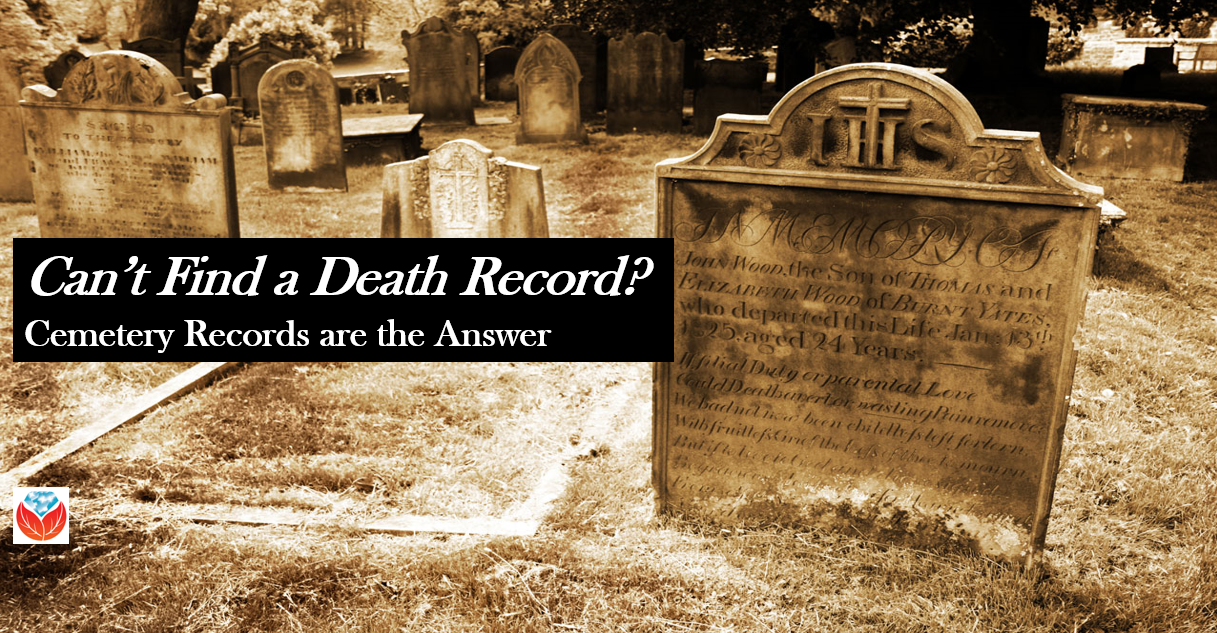



 This guest post comes from Paul Woodbury, a Senior Genealogist with
This guest post comes from Paul Woodbury, a Senior Genealogist with 




